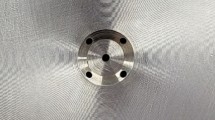Abstract
The effect of the temperature difference between the gas and the particles on propagation of premixed flames in a combustible mixture containing volatile fuel particles uniformly distributed in an oxidizing gas mixture is analyzed in this paper. It is presumed that the fuel particles vaporize first to yield a gaseous fuel, which is oxidized in the gas phase. The analysis is performed in the asymptotic limit, where the value of the characteristic Zel’dovich number is large, which implies that the reaction term in the preheating zone is negligible. Required relations between the gas and the particles are derived from equations for premixed flames of organic dust. Subsequently, the governing equations are solved by an analytical method. Finally, the variation of the dimensionless temperatures of the gas and the particles, the mass fraction of the particles, the equivalence ratio ϕ g as a function of ϕ u , the flame temperature, and the burning velocities of the gas and the particles are obtained. The analysis shows that the calculated value of ϕ g is smaller than unity for certain cases, even though ϕ u ⩾1.
Similar content being viewed by others
References
R. K. Eckhoff, Dust Explosion in the Process Industries, Butterworth-Heinemann, Oxford (1997).
B. Kaesche-Krischer and J. Zehr, “Untersuchungenan staubkuft-flammen,” Z. Phys. Chemie (new series), 14, 384–387 (1958).
W. E. Mason and M. J. G. Wilson, “Laminar flames of lycopodium dust in air,” Combust. Flame, 11, 195–200 (1967).
H. D. Ross, “Reducing adhesion and agglomeration within a cloud of combustible particles,” NASA Technical Memorandum No. 100902, National Technical Information Service, Springfield (1988).
C. Proust, “Experimental determination of the maximum flame temperatures and of the laminar burning velocities for some combustible dust-air mixtures,” in: Proc. of the Fifth Int. Colloquium on Dust Explosions, Pultusk, Poland (1993), pp. 161–184.
K. Seshardi, A. L. Berlad, and V. Tangirala, “The structure of premixed particle-cloud flames,” Combust. Flame, 89, 333–342 (1992).
D. Bradley, Z. Chen, S. El-Sherif, et al., “Structure of laminar premixed carbon-methane-air flames and ultrafine coal combustion,” Combust. Flame, 96, 80–96 (1994).
C. H. Proust and B. Veyssiere, “Fundamental properties of flames propagating in starch dust-air mixtures,” Combust. Sci. Technol., 62, 149–172 (1988).
B. Veyssiere, “Development and propagation regimes of dust explosions,” Powder Technol., 71, 171–180 (1992).
O.-S. Han, M. Yashima, T. Matsuda, H. Matsui, A. Miyake, and T. Ogawa, “Behavior of flame propagating through lycopodium dust clouds in a vertical duct,” J. Loss Prev. Process Ind., 13, No. 6, 449–457 (2000).
C. Proust, “Flame propagation and combustion in some dust-air mixtures,” J. Loss Prev. Process Ind., 19, 89–100 (2006).
C. Proust, “A few fundamental aspects about ignition and flame propagation in dust clouds,” ibid., pp. 104–120.
F. A. Williams, Combustion Theory, Addison-Wesley, Redwood City (1985).
N. Peters and F. A. Williams, “The asymptotic structure of stoichiometric methane-air flames,” Combust. Flame, 68, 185–207 (1987).
Author information
Authors and Affiliations
Corresponding author
Additional information
__________
Translated from Fizika Goreniya i Vzryva, Vol. 45, No. 3, pp. 49–57, May–June, 2009.
Rights and permissions
About this article
Cite this article
Bidabadi, M., Rahbari, A. Modeling combustion of lycopodium particles by considering the temperature difference between the gas and the particles. Combust Explos Shock Waves 45, 278–285 (2009). https://doi.org/10.1007/s10573-009-0037-1
Received:
Published:
Issue Date:
DOI: https://doi.org/10.1007/s10573-009-0037-1




